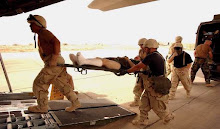By Steve Hammons
Two new documents by and about the U.S. Army are sparking discussion and debate about various elements of the Army’s missions and future directions.
Both documents, a field manual and a research study report, expand perspectives about achieving short-term and long-term success in various kinds of missions.
Taken together, along with other comprehensive considerations, these views might be considered part of an “outside-the-box” and valuable concept sometimes referred to as “transcendent warfare.”
The new Stability Operations Field Manual, to be released today according to an Oct. 5 Washington Post article, emphasizes the role of “stability operations” in countries and regions that include fragile states and failed states.
The article quoted Lt. Gen. William B. Caldwell IV as saying, "This is the document that bridges from conflict to peace." Caldwell is commander of the U.S. Army Combined Arms Center at Fort Leavenworth, Kansas. The manual was created with the past year at the center.
Another new document is a report by the Rand Corporation based on a study they conducted for the Army Environmental Policy Institute (AEPI). The report is titled “Green Warriors: Army Environmental Considerations for Contingency Operations from Planning Through Post-Conflict.”
The report notes that issues such as clean water, sewage and sanitation, proper handling of hazardous waste and similar challenges can affect mission success in establishing stability and support for U.S. missions by local residents, according to an Oct. 3 report in Newsweek.
How do the Stability Operations Field Manual, the Green Warriors research report and other approaches contribute to thinking and perceptions about transcendent warfare and future success for U.S. missions and activities?
HARD POWER, SOFT POWER, TRANSCENDENT POWER
When a U.S. Navy SEAL officer coined the term “transcendent warfare” several years ago, he was referring to the development of perspectives that include various advances in knowledge about psychology, sociology, physics, intelligence-gathering and other important elements.
The officer’s graduate-level research paper was titled, “Unconventional Human Intelligence Support: Transcendent and Asymmetric Warfare Implications of Remote Viewing.”
The 2001 report by then-Commander L.R. “Rick” Bremseth was part of his studies at the Marine Corps War College, Marine Corps University, Marine Corps Combat Development Command, Quantico, Virginia.
During and after extensive research and interviews, Bremseth noted that emerging developments and perspectives could be very helpful in various kinds of U.S. military and intelligence operations.
Do some of his research findings correlate with ideas such as those expressed in communications platforms such as the Stability Operations Field Manual and Rand’s Green Warriors study?
The answer is probably yes. Thorough, effective planning and implementation of those plans that take into account a wide scope of factors involved in U.S. military and intelligence activities can contribute to success.
While some comprehensive thinking may seem “outside the box,” some of it might be perceived as logical and common sense.
The Stability Operations Field Manual proposes that nations and regions that are havens for terrorism, criminal activities and religious extremism may pose a greater threat to the U.S. than the threat of major conventional battlefield wars.
The Green Warriors report noted that developing and sustaining the support from indigenous populations, such as in Iraq and Afghanistan, can be impacted by how well or poorly local circumstances involving clean water, sanitation and similar issues are handled.
The concepts in the field manual and the Rand report are not new.
The importance and value of comprehensive approaches in “winning hearts and minds” has long been recognized. Perhaps the value of these documents is to remind us that U.S. objectives can be achieved with “soft power” as well as the bombs and bullets of “hard power.”
The ideas of transcendent warfare simply add to the tools and options that are associated with both soft power and hard power.
NEW FORM OF WARFARE
Using Iraq and Afghanistan as examples, it is widely recognized that improving jobs and economic opportunity, getting business and agriculture up and running, providing basic services such as roads and electricity, opening schools and medical facilities, supporting the local communications media and similar activities all work hand-in-hand with hard-power military activities.
Making friends for America can be more helpful than making enemies.
Competence in the use of hard power, “killing people and blowing things up” as some like to say, is a given for military activities, whether we are talking about armies, navies or air forces. But, as we know, sometimes the battle is won but the war is lost.
What is sometimes a more challenging mission is to create peace, stability and long-term friends.
This assumes, of course, that the goal is actually to create stability and peace. When it is claimed or believed that military actions are undertaken for purposes of war-profiteering, to access natural resources such as oil or to intrude upon or dominate a specific region, then the moral authority of a military action will be questioned and possibly resisted.
It is possible that in some cases, conflict and war could be more desirable by some than peace and stability, at least by war-profiteers and those who have less-than-honorable motives.
Here again, perhaps transcendent warfare concepts can be of assistance. This is because some aspects of transcendent warfare look at human consciousness and human psychology in ways that can be helpful in a higher, deeper and more inclusive scope of understanding.
This can be helpful in dealing with other societies. And, it can be helpful in the understanding and advancement of our own nation.
In his Marine Corps War College report, Navy SEAL Bremseth noted that, "The real challenge for the United States is not asymmetric warfare, but rather what this writer calls transcendent warfare, the ability to conceptualize and subsequently actualize an entirely new form of warfare that transcends all previously known models."
He also stated that it would be useful to, "Explore a myriad of phenomena having potential military applications with the goal of developing transcendent and asymmetrical warfare approaches."
Using perspectives and methods that take into consideration the implementation of stabilization activities, peace operations, constructive psychological operations (PSYOP), information operations, open-source intelligence (OSINT), unconventional approaches, transcendent warfare concepts and other tactics and strategies might be very helpful now and in the future.
skip to main |
skip to sidebar

In the past 30 days, readers from approximately 40 countries or territories using about 20 languages visited the Joint Recon Study Group site.

To see more articles, scroll down the right-side column.

Steve Hammons

Articles from the Joint Recon Study Group site and Transcendent TV & Media site are included.
The Joint Reconnaissance Study Group is the San Diego-based, combined-service/agency, research-and-activities team in my novels "Mission Into Light" and sequel "Light's Hand." This site contains information of interest to the JRSG.
Home page: Joint Recon Study Group site
Readers from around the world visit this site.

In the past 30 days, readers from approximately 40 countries or territories using about 20 languages visited the Joint Recon Study Group site.
April 2021 threat alert: ‘Force protection’ for our troops now the responsibility of all Americans
First responders must deal with society’s problems, shortcomings, injustices every day
Could some UFOs be linked to Native American 'white stone canoe' legends, stories?
Wildland firefighter basic training available at community colleges, tech schools, training centers
‘Boomer remover’ coronavirus is bigger threat to WWII generation that saved the world
‘Black swan’ events that aren’t: Coronavirus, climate emergency, unidentified aerial phenonema
Reagan’s complete 1987 UN message on ‘alien threat’ overlooked: Grave danger here, now
Was Reagan briefed about UFOs and original ‘Day the Earth Stood Still’ movie?
My military draft lottery number was #165 during final Vietnam War years
“Keep On The Sunny Side,” by The Whites, from movie O Brother, Where Art Thou?”
Living along Ohio River for centuries, Native Shawnee called it ‘Kiskepila Sepe’ – ‘Eagle River’
Native American words around us: States, towns, rivers, lakes, terrain, plants, animals, military
Athens County, Ohio, was key spot when colonists, Redcoats fought Shawnee in 1774 battle
1787 Northwest Ordinance set course for Ohio, Indiana, Illinois, Michigan, Wisconsin, Minnesota
Smallpox-tainted blankets were 1763 bioweapon on northern Appalachian Mountains frontier
Diana Krall performs “Maybe You’ll Be There" live in Paris with Paris Symphony Orchestra 2001.
Books to read in 2021? Novels "Mission Into Light" and the sequel "Light's Hand"
Novel excerpt: Renew, prepare America with ‘Urgent Response Group’ for teens, young adults
Diana Krall performs “I Get Along” live in Paris with Paris Symphony Orchestra 2001.
Steve Tyrell sings “Give Me the Simple Life.”
Diana Krall performs “Love Letters” live in Paris with Paris Symphony Orchestra 2001.
Visit the article archives!

To see more articles, scroll down the right-side column.
Novel "Mission Into Light" overview on Amazon
Novel "Light's Hand" overview on Amazon
Adventures of the Joint Recon Study Group: Overview and synopses of activities and operations
Key chapter overviews: Points of interest in the novel "Mission Into Light"
Key chapter overviews: Points of interest in the novel "Light's Hand"
Multimedia rights available
English and foreign-language book rights, audio book and e-book rights for "Mission Into Light" and "Light's Hand" are available. Movie and TV rights are available.
I'm seeking agent representation for these works and rights.
Please contact Steve Hammons for more information at hammons55@gmail.com.
Feature film screenplay
I completed a feature film screenplay in 2006 based on “Mission Into Light” and “Light’s Hand” combining key elements of both novels.
The screenplay takes audiences into the adventures and discoveries of the Joint Recon Study Group and the relationships among team members, friends and associates as they explore leading-edge research and emerging transcendent developments.
I'm seeking agent representation for this screenplay.
.........................
I also wrote a TV series pilot script based on "Mission Into Light" and "Light's Hand" story. I'm seeking agent representation this script.
About the Author

Steve Hammons
About the Author
I was born and raised in southwestern Ohio near the Kentucky and Indiana borders, then went to college at Ohio University in the southeastern Appalachian region of the state near West Virginia.
I graduated with a dual major in communication (journalism focus) and health education (psychology focus) with a minor in pre-law.
Ohio U. is home to the respected Scripps College of Communication and E.W. Scripps School of Journalism.
I also completed two graduate-level courses in guidance counseling theory and method at Ohio U.'s College of Education, School of Applied Behavioral Sciences and Educational Leadership.
At the end of my undergraduate education at Ohio University, I moved to the beautiful American Southwest where I applied my education, continual training and and ongoing experience to related professional fields such as health care, journalism and special research areas.
My novels "Mission Into Light" and the sequel "Light’s Hand" are available in e-book and 6"x9" paperback from most online booksellers worldwide.
Readers review metaphysical-military-intelligence adventure novel ‘Mission Into Light’
My articles on DoD CultureReady blog, Defense Language and National Security Education Office
Transcendent TV & Media site
Past articles: Scroll down the right-side column for more articles.

Articles from the Joint Recon Study Group site and Transcendent TV & Media site are included.































































































































































































